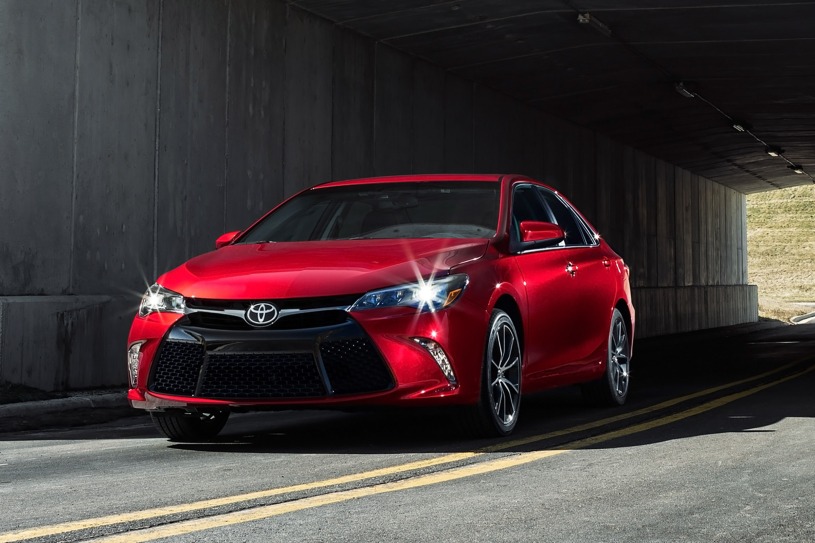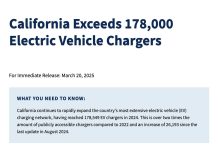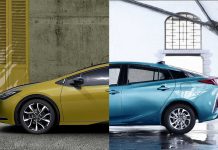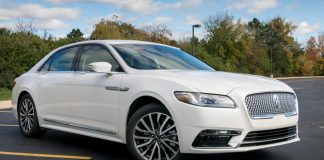It’s smart that Toyota has undercut Honda on the price of the new Camry hybrid. You can pick one up for about $2,500 less than you’d pay for the a new Accord hybrid.
This makes up for the Mileage Deficit between the two.
The EPA says the hybrid Camry LE is capable of 43 city and 39 highway (best case; the higher trim XLE’s rating dips to 40 city, 38 highway – probably because it has a larger wheel/tire package that adds drag).
These are very good numbers for a mid-sized/family sedan.
But the Accord’s numbers are even better:
50 city and 45 on the highway – and that goes for all trims.
That’s as much as a 10 MPG difference in the city – and seven on the highway.
The Ford Fusion hybrid is strong contender, too. It rates 44 city and 41 on the highway.
And it costs less than either the Honda or the Toyota.
What the Camry hybrid’s got in its corner, though, is that it’s a Camry – for ages, the best selling family sedan on the market. It’s the go-to/safe-bet choice for literally hundreds of thousands of loyal Toyota buyers. And it’s still a good car, worth considering.
But it definitely has serious competition.
And not just from its obvious rivals.
The hybrid Camry is the gas-electric version of the popular mid-sized Camry sedan.
Like its main rivals – the Honda Accord hybrid and the Ford Fusion hybrid – it offers much better low-speed/stop-and-go/city-driving mileage than the gas-engined versions of those cars – and a decent MPG uptick on the highway as well (especially relative to the V6 gas engined versions of those cars).
It’s also a quicker than the four-cylinder/non-hybrid Camry.
Be aware, though, that with gas prices at pretty reasonable levels, it’s become harder to make a strong economic case for spending the extra money on any hybrid vs. the conventional/gas-engined version of the car in question.
The Camry hybrid, for example, starts at $26,790 – vs. $22,970 for the same basic car (LE trim) in non-hybrid form.
So, about $3,820 more up front.
You could also cross-shop a diesel-powered car like the current VW Jetta TDI or the diesel version of the Chevy Cruze. Their real-world mileage is extremely competitive – and they’re less expensive.
All Camrys get a updated bodywork, including a front clip that’s more Lexus-like (and less Mrs. Doubtfire-esque).
The hybrid’s powertrain carries over unchanged but Toyota has sharpened up the car’s handling to go with the no-longer post-menopausal visuals.
The hybrid is sold in the same LE (base) SE (sporty) and XLE (luxury) trims as the non-hybrid Camry but being hybrids, they all come with a different instrument cluster and hybrid-specific readouts, including real-time monitoring of the efficiency of the hybrid powertrain.
Familiarity. The safe bet. The Camry hybrid may not get the absolute best mileage or be the least expensive to buy hybrid – but it’s got a bulletproof reputation, including an established track record of high resale values.
Quicker acceleration than non-hybrid/four-cylinder Camry – and much better mileage, too.
More second row headroom than Accord hybrid – and a lot less expensive.
More than a second quicker to 60 than Ford Fusion hybrid (which is – by far – the slowest of the bunch).
WHAT’S NOT SO GOOD
Accord hybrid’s mileage is much higher.
Hybrid Fusion’s price is lower (and its mileage is higher, too).
There are diesel-powered alternatives out there that match or exceed all these hybrids’ mileage – and cost less to buy, too.
The hybrid Camry’s drivetrain consist of a 2.5 liter gas engine supplemented by an electric motor and battery pack – the battery pack getting its charge from a combination of the engine (which acts as an onboard generator) and the “free” electricity captured during deceleration via regenerative braking. Basically, the brakes act as generators, too – only they are powered by the car’s forward momentum.
The combo produces a total peak output of 200 hp – which is 22 hp more than the non-hybrid, four-cylinder Camry LE (178 hp).
So, you get a bit of a performance boost – zero to 60 in about 7.5 seconds vs. 8.3 for the non-hybrid/four-cylinder Camry – and a significant uptick in fuel economy. The regular four-cylinder Camry rates 25 city, 35 highway – far lower than the Camry hybrid’s best-case 43 city, 39 highway.
The Camry hybrid’s numbers are lower (40 city, 38 highway) if you go with the higher trims, which come with a larger 17-inch wheel/tire package vs. the 16-inch steel wheels that are fitted to the base LE trim.
Still, the numbers are very good relative to the gas-engined/non-hybrid Camry LE. Whether they’re good enough to justify the $3,800 or so price bump is something you’ll have to decide – based on how many miles you drive and also on how you drive.
If your driving is mostly at lower speeds (stop and go, commuting) then the hybrid can and probably will earn its keep. But if you do a lot of highway driving – at today’s real-world (if not necessarily legal) highway speeds (75-80 MPH) then your mileage may be disappointing in the context of what you paid – vs. what you might have paid for the non-hybrid Camry.
I have found that hybrids – not just the Camry, but generally – average in the low-mid 30s on the highway at speeds in the 75-80 range. Many current gas-engined cars can do nearly as well as that – and a couple of diesel cars I’ll tell you about in a minute can do better.
The Accord hybrid is slightly quicker than the Camry hybrid – and (as mentioned) gets significantly better mileage, without any MPG penalty for going with a higher trim.
It does, however, cost more to buy the thing.
The Fusion hybrid is a lot less quick than either (zero to 60 in a bout 8.6 seconds) but it is without question the deal of three. You can pick one up for $1,115 less than a hybrid Camry LE (and $3,630 less than an Accord hybrid) and its mileage is slightly better than the Toyota’s and not too far behind the Honda’s.
Ford and Honda also sell plug-in versions of their hybrids – while Toyota does not offer that feature with the Camry hybrid. The advantage of being able to plug the car in to an external power source is that it’s not necessary to run the engine (and burn gas) to charge up the battery pack. Your household current does that job instead.
This increases your mileage significantly.
Also, the plug-ins have more powerful batteries – and (typically) can operate at higher speeds (and for longer) on just the batteries, without assitance from the gas engine. This makes it possible for some drivers – depending on the length of their trip – to use no gasoline at all.
Or less, at any rate.
The downside is the cost to buy in.
The plug-in Accord’s base price is $39,780. A plug-in Fusion “energi” starts at $33,900.
They have not sold well.
Which is probably whey Toyota decided not to sell a plug-in version of the Camry hybrid.
The main quality that sets the hybrid Camry (and Accord and Fusion hybrid) apart from hybrids like the Prius is their hybridness is more in the background. These cars look like normal cars and – mostly – drive like them, too.
There are some obvious clues – the big one being that when you push the ignition button, there’s usually no sign of life whatsoever. It’s like turning the key to “accessory” in a conventional car except that in addition to being able to listen to the radio, you can also drive the car.
The gas engine may kick on at “start up” if the battery’s charge is below a certain threshold or it’s cold outside (and you need heat, which is provided by a warm – and necessarily, running – engine). But assuming it’s warm outside and the battery is fully charged, you’ll be able to creep down the road on the batteries and electric motor for about a mile or so – and up to about 30 MPH – before the gas engine does kick in.
Which it will do unobtrusively.
There’s no tachometer in the Camry hybrid, so your main clue that gas is being burned is the LCD display that shows the power split (which part of the hybrid powertrain is working at any given moment).
The gas engine is nearly silent – even when it’s running.
The standard continuously variable (CVT) automatic works conventionally and has a conventional, center console-mounted gear selector that feels like it’s connected to something, unlike the dashboard-mounted toggle thing in the Prius.
Acceleration is quite good.
In fact, if you cross-compare the numbers, the hybrid Camry is only about 1.2 seconds less quick to 60 than the V6 powered Camry, which is capable of a 6.1 second run.
But the V6 Camry doesn’t get 43 (or even 40) MPG.
Not unless it’s being pulled by the hybrid Camry.
The downside, though, is that the hybrid Camry sounds as though it’s struggling at times.
Chiefly, it’s because of the operating characteristics of the standard continuously variable (CVT) automatic. Which is the type of transmission you’ll find in all current hybrids, because CVTs are more efficient. And that’s what hybrids are all about.
Or at least, mostly all about.
The thing with CVTs is they’re thrashy. When you tromp on the accelerator, the CVT’s gearless/shiftless (basically there’s just one speed – forward) design causes the engine to spin right up to (or very near to) redline; it then stays there – if you keep your foot down – because there’s no next gear to shift up (or down) to. The effect is of an engine (plus batteries and electric motor) given’ er all she’s got cap’n. You can almost hear Scotty’s voice coming through the speaker.
I dinnah know how long she’ll hold together!
Now, to be fair to the Camry – and hybrids, generally – this issue only (or mostly) arises when you are demanding maximum effort thrust. If you’re not, the CVT is quiet and – by its nature – smooth as a young Billy Dee Williams. Remember, no shifts – so even when you’ve got it floored, there are no transitions in between gear changes.
Because the CVT has no gears to change. 
And in stop and go traffic, the Camry’s hybrid powertrain transitions from electric to gas to some of both gracefully, snoothly – and quietly. In fact the Camry hybrid is a proverbial cotillon queen in this respect – compared with the obnoxious “auto-stop/start” feature being fitted (like it or not) to more and more gas-engined cars. They shudder and shake, some of them – and keep in mind that when their gas engines are turned off, so is pretty much everything else, including the car’s AC. In a hybrid. pretty much all the accessories are driven electrically and powered by the battery pack. So even with the gas engine off, those things are still all on.
Last item: Toyota has butched-up the Camry’s handling (regular models and the hybrid) to go with the butched-up looks. That does not mean it’s Bruce Jenner, circa 1976.
But it’s also not Caitlyn, circa 2015.
It is somewhere in (you knew this was coming) transition. Not quite as athletic as the Accord, which is the decathlete of the three. But closer than it used to be. And as or more engaging to drive than the slow-motion Fusion.
This will hopefully (if you’re Toyota) not antagonize the traditional buyers – most of whom are older and have little, if any, need for speed – while also not disappointing the younger crowd, drawn in by the more vigorous looking bodywork.
So, notwithstanding its main mission – to save on gas – Toyota offers the same sport-themed SE package that’s available with the regular Camry. It includes a larger (17 inch) wheel and tire package (55 series Michelin Primacy MX4Vs), firmer suspension calibrations, a trunk spoiler, blackout trim for the headlights, sport seats and SE-specific interior accents.
Just be aware – per the above – that going with the larger wheel/tire package will cost you a couple or three MPGs.
Toyota knows that it cannot rest forever on the laurels of its Blue Chip aura. Because the competition also offers excellent build quality, reliability, value – and good looks.
People want more than just a very good appliance.
Hence the new good looks – or at least, more distinctive (and less doughty) looks. The ’15 Camry – hybrid and standard-issue – get the “sweeper” front end treatment that debuted with Lexus and has filtered down the line to Toyotas – even including the Corolla.
The interior has been Lexus-upped in both form and materials, too. The dashpad’s cantilevered shape is similar to what you’d find in a Lexus IS. Add the available LED headlights and you’re almost there. 
The Camry is now a member of the club, properly inducted.
Some small but very clap-worthy changes include relocation of the USB charge port to the cubby ahead of the shift lever – where you can easily see (and reach it) as opposed to its previous location in the center console, where you could not see (much less reach it).
Right next to the USB port is the Qi wireless cell phone charger. It’s optional, but worth the money.
Standard in every Camry are large buttons and knobs for most of the major secondary functions. They are twice the size of the typical button/knob and so much easier to touch (or turn) accurately with the vehicle moving.
The hybrid’s gauge cluster has a large analog Power/Charge/Eco readout in place of the standard Camry’s tachometer, with an also hybrid-specific Energy Monitor LCD display that tells you how much gas you’re using at the moment as well as how much gas you’ve used – on average – over a given period of time (days, several days, a week – etc.).
According to the computer, I averaged 32.6 MPG during my weeklong test drive – with a daily best of 41.2 MPG.
THE REST
This brings up another issue – a lateral, as they say in football.
Diesels.
If you can handle a slightly smaller car – with a bit less back seat room – you may want to at least go take a look at the VW Jetta TDI (review of the ’14 version here) and maybe also the Chevy Cruze diesel.
The VW averages 38.5 MPG (31 city, 46 highway) and – trust me – the highway number is lowball. It’ll do better than what the EPA says it’ll do.
Same with regard to the Cruze diesel (which averages slightly less, 36.5 MPG).
Both cost less, too – in the case of the Jetta TDI, thousands less. You can pick one up for $21,640 – which works out to an “up front” savings of $5,150 vs. the base Camry hybrid. Given that the VW diesel’s real-world/everyday mileage is as good or even better than the hybrid’s mileage, that’s money in your pocket that will stay in your pocket.
The Cruze costs more ($25,660) but Chevy sells it loaded with equipment and options and it compares very favorably with the higher trim SE and XLE versions of the Camry hybrid.
So, again, you may want to give it a gander.
I have often wondered why Toyota – and the other car companies – have not explored the possibility of a diesel hybrid. It seems like a no-brainer. Diesels make lots of low-RPM power (torque) which would be ideal – so it would seem – both for acceleration and powering/charging up a battery pack. Most serious building generators are powered by diesels – not gas.
Imagine the mileage potential of combining a 45-50 MPG-capable diesel with a hybrid electric motor/battery pack… in lieu of a 21-28 MPG-capable gas engine.
THE BOTTOM LINE
It’s still a contender – but there is definitely competition for the title.
And not only from other hybrids like the Accord and Fusion.
If you value independent media, please support independent media. We depend on you to keep the wheels turning!
Our donate button is here.
If you prefer to avoid PayPal, our mailing address is:
EPautos
721 Hummingbird Lane SE
Copper Hill, VA 24079
PS: EPautos stickers are free to those who sign up for a $5 or more monthly recurring donation to support EPautos, or for a one-time donation of $10 or more. (Please be sure to tell us you want a sticker – and also, provide an address, so we know where to mail the thing!)




















I think the reason diesel hybrids aren’t in production is because of the structure of a diesel engine. The flywheels and the cylinders are very sturdy and hence, heavy. To keep the flywheel spinning, in the hybrid, would require lot of battery power. Quickly switching the engine from on-to-off and vice verse while running can damage the engine.
Also, diesel engines work due to high temperature and pressure inside the upper cylinder. A hybrid would make this too complex and production cars would run into problems and fixing would take more effort/skill than companies are willing to risk. Can’t find source right now but it was published in an article. Also, I am engineer with interest in alternate energy cars.
Good stuff, Ray – that makes a lot of sense.
Hat tip!
I believe it’s also typical in diesel/electric setups the diesel is only charging batteries running at constant RPM. The traction motors are electric.
My personal interest into this was about 30years ago, small diesel generator on a trailer behind a home built electric.
But really neither diesel/electric, gas/electric or full electric make economic sense. Even the higher cost of straight diesel is hard to justify when diesel fuel is priced higher then premium gas in any places.
In my experience manual transmissions also do better in the real world than autos do relative to the EPA test.
I agree. But I think that is because of the driving practices and shifting decisions we take. We shift at lower rpms and downshift from 5th to 3rd or 2nd directly.
Lately, cars manufacturers have been countering this by having lower gear ratio in final drive of auto cars than in manual cars. So please think the AT car has higher gas mileage, but it is only a marketing gimmick. Check Scion FR-S for proof.
eric, some friends bought a 2012 Camry hybrid(I wouldn’t have, but that’s just me) and they love it. From the first tank of fuel they continue to average 42mpg hiway. They were gladly amazed that it was 3mpg higher than it was supposed to be. This car is driven in an area of 55-65 mph PSL’s and plenty of driving in 30-50 mph PSL’s too with lots of curvy, stopping and some 75mph PSL but very little. It would be hard to figure what sort of car would get the best mileage where they drive but a continuous 42 mpg is damned good in my opinion since I seem to use plenty diesel in their part of the country. Up hill and holding brakes downhill due to frequent radar, intersections on the not so open road and various stops and starts always seemed to drain my old diesel pickup more than 85 mph I-10 driving.
They have had no problems with it other than body damage from deer. They live in one of the hottest parts of Tx and have never complained about a lack of a/c efficiency….nor anything else…..except deer strikes.
Eight,
I always expect to get 2-3 mpg less than the epa stickers claim. I had a 2007 camry a while back and I got 32-33 mpg–I believe the epa claimed 30 on those–out of it at 80-85. I have never had another car where I exceeded the epa mpg estimate. Currently the wife has an 08 Lexus. She gets 27-28–about what the epa claims. I never beat 26. But I have a damn good time driving it.
ancap, I’m trying to remember the last time I drove a car. That’s depressing. I have various International Eagles, KW’s, (sometimes a nice Volvo) and an old Pete beat me up all day and then climb into that leather seat on that old Chevy and I’m in heaven. I’d probably have a religious experience in a nice car. Too bad automakers don’t have a stand-out like Peterbilt. We recently bought a pretty new Eagle(yeah, I know)and the 23 year old immediately(he likes to do this with every new truck)claimed it for his own. That means nothing for the most part but i had to use it to do some hotshot loads in far west Tx. and NM. That rough SOB nearly beat me to death and I lost the battery cover. I notice the kid doesn’t refer to that Eagle as “my Eagle” now as he always referred to the Pete(My Pete). I climb up into a cab that’s a foot and a half closer to the ground with a combo steel and airbag spring system that’s far superior to these big air-bagged trucks, and smile my way past him. One Eagle, with a 750 HP Red Top Cummins has a turbo shriek like I never heard before. Just a terrible loud noise but it’s terribly powerful too. In that Eagle though, it’s humping, jumping, beating you silly sort of thing. In that Pete? Engine? What engine? Oh, I barely hear a little whine and hear the stereo much better.
A young guy(boss)bought that Eagle new and I drove it two days and he thinks I abused it since the clutch is shitty(he had to admit it), the new transmission is balky as hell(he got in and went for a drive and never said another word) and it comes on some big bumps at high speed and throws the trailer and the front end up and down, beating hell out of you and wondering if you’re going to keep control.
I’d be glad to drive your wife’s Lexus. Every one I drove was nice. I recall the first one I drove and it was nice.
Why are EPA numbers for diesels alway a lowball? Outdated testing methodology? Or do they not want the evil diesel over the clean electric?
It might have to do with what cetane number fuel they use -vs- what’s available in the real world. I know that I get better milage with fuel from some stations than from others, and that mostly correlates to the price. And fuel with a higher cetane number is usually more expensive. Unfortunately stations don’t publish their fuel’s cetane number so I can’t say for sure.
Of course, there seems to be some debate as to whether or not cetane number has any correlation to mileage, so YMMV.